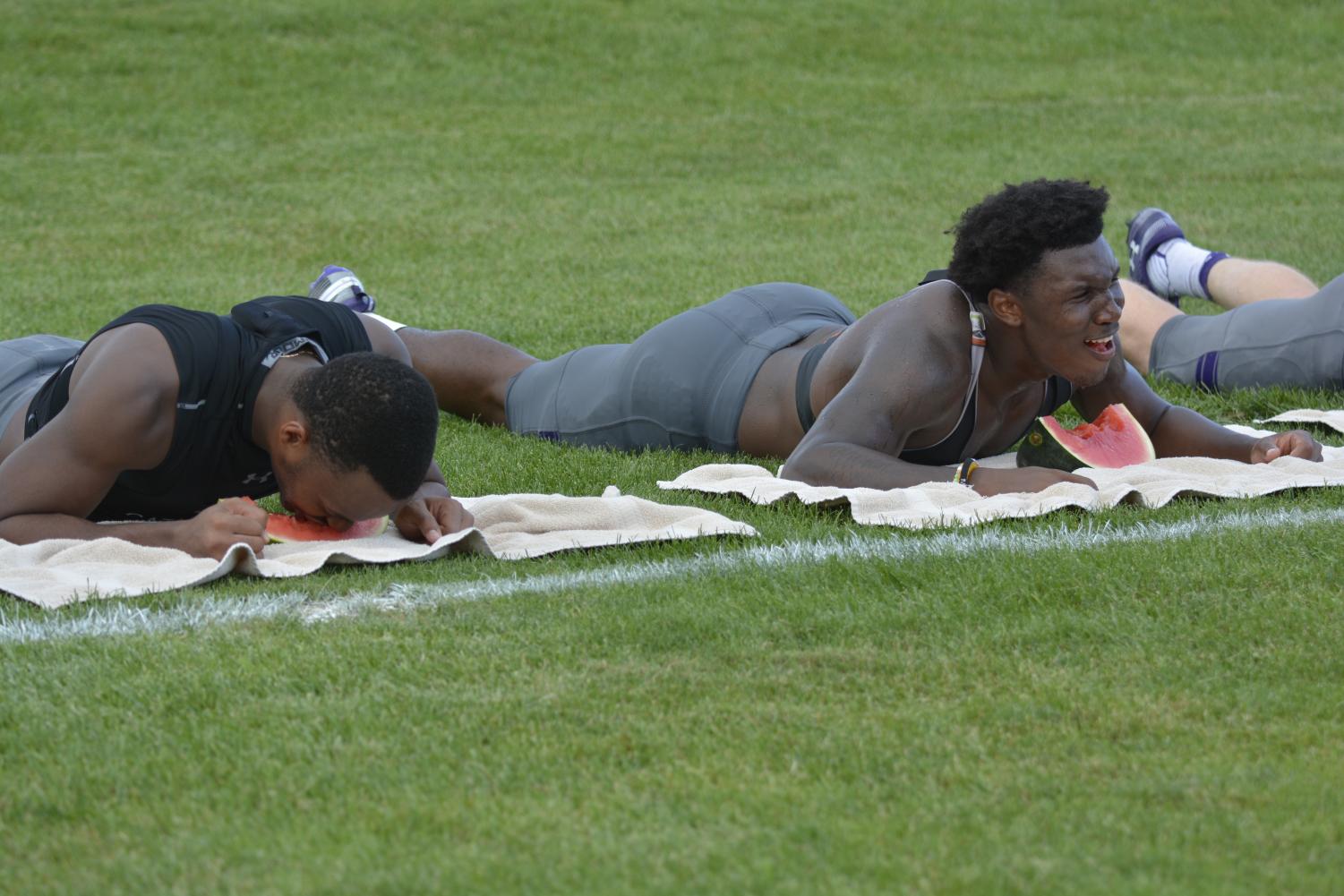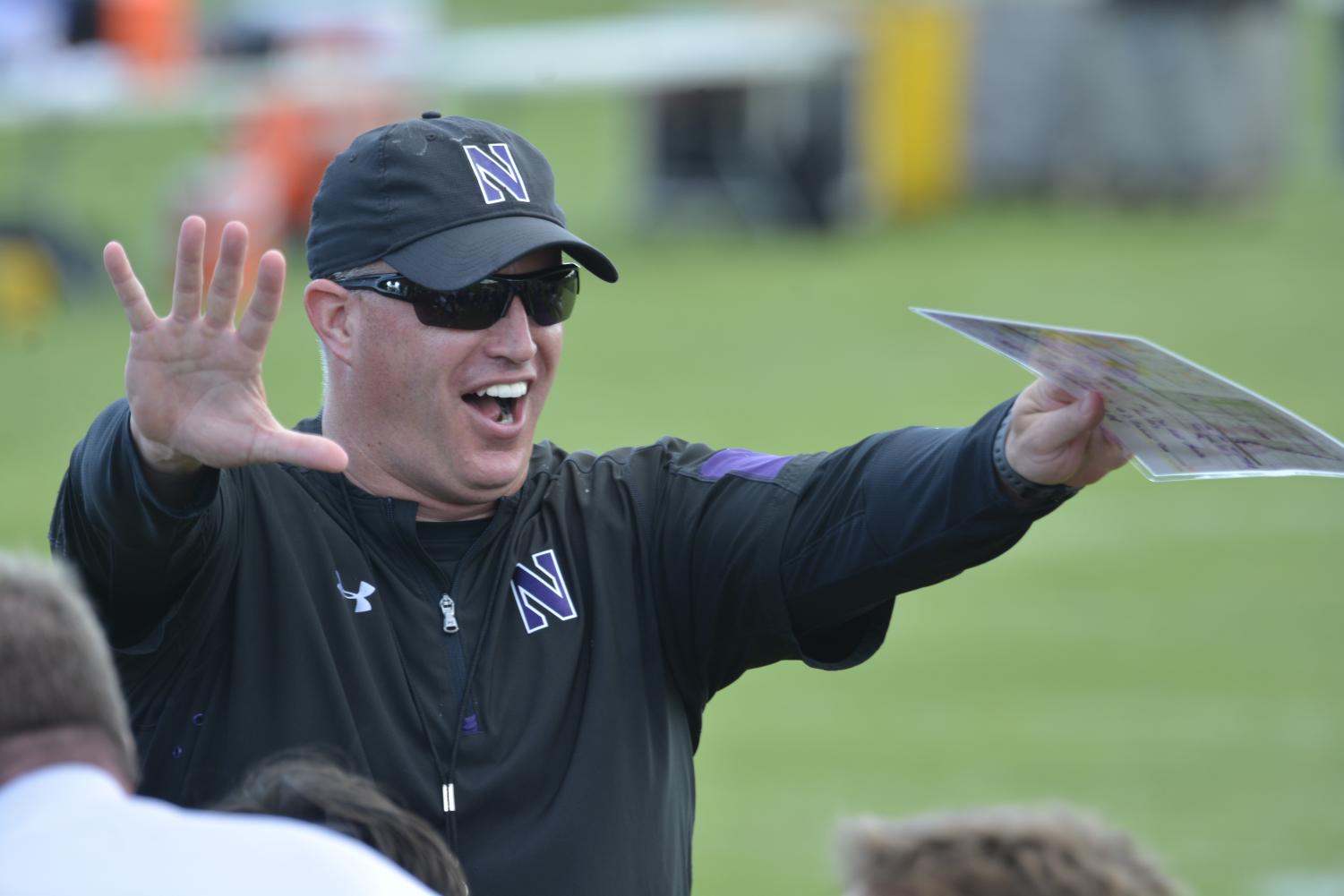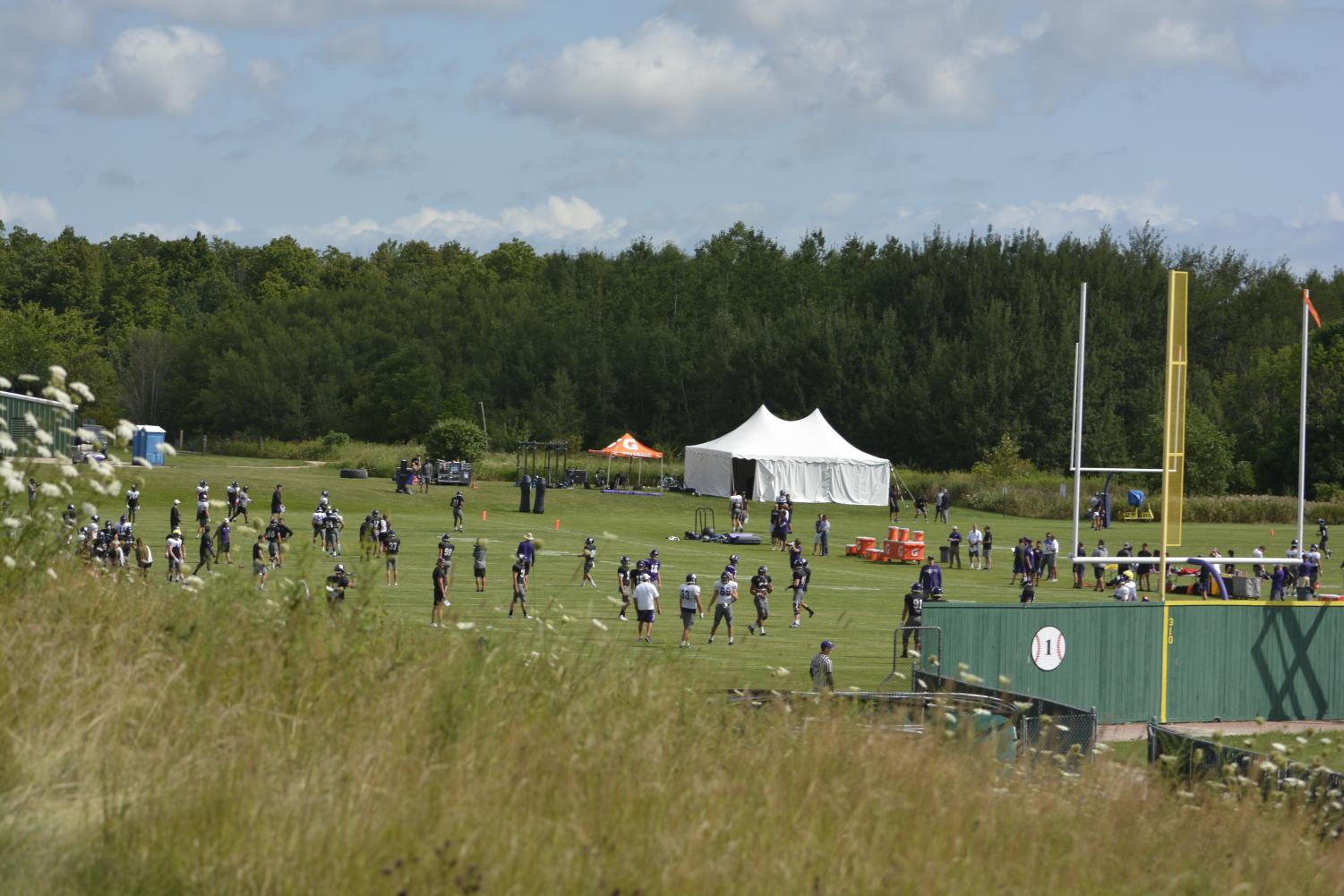Football: The bonds of the Northwestern brotherhood are formed at Camp Kenosha
August 21, 2019
Football
KENOSHA, Wis. — For over 11 months of the year, the southern view of the University of Wisconsin-Parkside’s campus looks exactly the same.
On the corner of Somers Road and Wood Road is a teal sign announcing one’s arrival to the campus. Trees and bushes hide most of the Sports and Activity Center, the southernmost building on campus, until a half-mile up the road. And the Ken “Red” Oberbruner Baseball Field is hidden from view at the intersection, except for two towering, yellow foul poles that mark the quaint diamond’s location.
For over a week every August, however, there is one addition to the skyline: a white goal post.
Passing right in front of the baseball diamond, another white goal post comes into view, as well as the top of a white tent. At the right time, three blue aerial lifts will be high above the goal posts too.
Oberbruner Field’s green outfield wall blocks the view of what’s happening below the three lifts and two posts. But a walk up a slight hill with untrimmed grass beyond the third-base line provides a panoramic view of the scene.
Two regulation-size football fields run north-to-south and parallel to each other, with each grassy field holding only one goal post on opposite ends. The fields are nicely-trimmed, but far from perfect surfaces — for one, the east field is concave. Players in white, black and purple pinnies run around these imperfect pastures. Coaches yell and teach, student managers do their jobs and, on this day, the weather is particularly humid.
On the north end, Waka Flocka Flame’s banger “Grove St. Party” plays through a large speaker, with its chorus of “It’s a party. It’s a party. It’s a party.” bumping throughout the isolated practice area.
It’s not a party, though. It’s Camp Kenosha.
A Northwestern tradition, the Wildcats spend at least a week practicing at Wisconsin-Parkside’s campus every August. NU has been doing it since 1992 and over time, Camp Kenosha has become a part of Cats lore, and something of a mystery to those who haven’t experienced it.
But for the players, coaches, staff and others who have spent some time sleeping in the dorms, playing on the field or eating the campus food, Camp Kenosha is more than just a couple of practices away from Evanston.
“You can’t have Northwestern football without Kenosha,” senior center Jared Thomas said.

A view of the campus of Wisconsin-Parkside from the corner of Somers Road and Wood Road heading west. One of the goal posts set up by Northwestern for the camp can be seen in the distance.
At the end of Thursday’s practice as the players finish their conditioning drills on one field, student managers place beige towels on the end line of the other, setting a slice of a juicy, seedless watermelon on each one.
Once the players finish conditioning, they are called over to the other field. Players past their first Camp Kenosha know what’s about to happen. They stand along the goal line, jumping and readying for a Camp Kenosha tradition. The freshmen and other newcomers are told to find a spot along the end line.
Coach Pat Fitzgerald addresses the team, and announces that the 2019 watermelon eating contest is set to begin. He explains the rules — no hands until the second whistle — and says the coaching representative will be first-year offensive line coach Kurt Anderson. The decision sends everyone into a frenzy.
The competitors lie on their stomachs, and when the first whistle blows, they stuff their faces in the pinkish flesh of the fruit. As the new players — and Anderson — gnaw their way through the slices, upperclassmen and coaches cheer them on. They form circles around Anderson and some of the players making quick work of their snacks, cheering, encouraging and laughing. It’s the type of activity that helps turn a group of individuals into a team.
But for NU, being just a team is not enough.
“Anyone can call themselves a team,” senior defensive end Joe Gaziano said, “but I think we pride ourselves on being a brotherhood.”
And the Cats believe Kenosha is a driving force behind the formation of that brotherhood.
Every August, Kenosha becomes the NU’s second home. Wisconsin-Parkside does not have a football team, so the Cats create their own practice area in a large grassy meadow north of Oberbruner Field. They use the school’s dorms and dining halls. Back when Camp Kenosha was two weeks or more, players would have a chance to leave the rural campus and visit downtown. Now, they stay the whole time on campus, never exploring the fourth-largest city in Wisconsin.
“I never knew there were over 100,000 people in Kenosha till I left,” said running backs coach and former NU player Lou Ayeni.
Wisconsin-Parkside has always provided a change of scenery for the team. But compared to Ryan Fieldhouse, the Walter Athletics Center and all of the Cats’ new amenities, the difference is remarkable. It is quite different from where a casual observer would expect “Chicago’s Big Ten Team” to spend its most formative week practicing.
Plenty of bonding goes on in Evanston during spring practices, summer workouts and early fall camp. But Kenosha is where the glue that holds the team together through the grind of the season is molded.
“As much as we train and as much as we work in offseason starting in January, when we put the pads on and come here, this is when it really ties together,” junior linebacker Paddy Fisher said. “I think this is just the foundation of the team.”
The dorms, which Fisher described as “not bad, to be honest,” are set up so players from the same position groups are rooming with each other. Each position group also has its own lounge area, but everyone has free reign to roam around and visit different spots.
In the dorms, players are either sleeping or doing something with teammates. Some play video games like Super Smash Bros. Others are playing cards — spades is the team’s game of choice — and others watch television.
“It’s tough to get through Kenosha if you don’t talk to anybody the entire time,” Gaziano said. “You need moral support. You need physical support. That comes from teammates, and that’s kind of how we form that trust and that bond that creates a brotherhood at the end of it.”

Newcomers compete in the Watermelon Eating Contest. Fitzgerald said the contest had been going one for 14 years.
In 2002, Tim McGarigle made his first visit to Kenosha as a freshman linebacker. He was the only freshman without a cell phone and said he had to walk “a long way” to reach a payphone to call his parents, to whom he promptly asked for a phone of his own.
Seventeen years later, McGarigle, now the linebackers coach, returned to Wisconsin-Parkside for his seventh go-round. He now has a cell phone. When he arrived on campus, he uses the phone to take photos of the dorms, and then sends the photos to 15 of his former teammates.
“They all got back to me with little memories and little tidbits, whether good or bad,” McGarigle said. “It was funny to hear back from them, and all of them have their little take and tidbit. It’s a bond that always will be there.”
He made the drive up to Wisconsin with Ayeni, the only other assistant coach on staff to have attended Camp Kenosha as a player. The two reminisced about their time wearing the shoulder pads in the humid Wisconsin heat, and as they got closer and closer to campus, the memories kept coming and coming.
And when they reached their destination and McGarigle went to the dorms, Ayeni followed. He also took photos and forwarded them to some of his former teammates.
“The emojis they sent me were really interesting,” Ayeni said.
It was in those dorms that Ayeni and McGarigle bonded with their teammates as players. Now, they’re bonding in the dorms with their fellow coaches.
When finished preparing for practice, the coaches will usually sit together and watch television, McGarigle said. Fitzgerald said the staff looks forward to Thursday nights because they can all agree to watch Thursday Night Football. But when that’s not on, Fitzgerald said the television shows they watch are “not very good ones, to be quite honest.” They try to find funny programs, he said, in order to share some laughs.
There are coaches-only traditions as well. One is a staff dinner where Fitzgerald takes the whole group out to eat. Another is a golf outing on the Sunday off day.
On that trip to the Kenosha Country Club, special teams coordinator Jeff Genyk, defensive backs coach Matt MacPherson and director of player development and football relations Jacob Schmidt — a trio Fitzgerald calls the staff’s “three resident outstanding golfers” — are usually at the top of the scorecard. Fitzgerald said the coaches have gotten close with some of the club’s members and it has become a “really cool staff tradition.”
“It’s the same for the coaches as it is for the players,” McGarigle said. “We get a week together to get closer as a staff too and get to know each other in a way that you probably wouldn’t be able to if we had it in Evanston.”

Pat Fitzgerald address the team at the end of practice. This year’s trip to Kenosha is his 23rd time making the trek.
When practice ends for the day, the players complete their final group stretches, but that does not mark the end of the day. In Kenosha, it’s all football, so there are other gridiron-related things on the schedule to complete. In Evanston, the facilities for the team are located in a central area, meaning the trek from place to place is fairly simple.
Not in Kenosha.
The Wisconsin-Parkside campus is more than three times the size of Northwestern’s land on the lakefront, and the Cats use different buildings all over the serene campus. The players don’t have cars, bikes or motorbikes to get them from one place to another. They have to walk. And the routes from place-to-place aren’t as simple as a morning stroll down Sheridan Road from Tech to Deering.
There are curves in the pathways and the surface is not level. Surrounding them on their walks are not only tall oaks, firs, birches and a bevy of species of trees, but also colorful flower beds and even a few of the school’s 18 disc golf holes.
On the way to practice, the final descent is a downward-sloping gravel path from the Sports and Athletic Center to the two fields, which is about 300 steps. Passing by the softball field on one side and a small valley with a track on the other, these final steps can spark the mindset for the rest of the day.
“I think everybody has their different thoughts and feelings with it,” Fitzgerald said. “It’s just kind of, ‘Get your mind right.’ And then when you walk it back up, you feel like you’ve accomplished something.”
But the walks aren’t just for solitary moments of focusing. For a team focused on forging a brotherhood, the walks — no matter how far — represent more chances to strengthen bonds.
Fisher said the walks provide some of his favorite memories of his four trips to Kenosha. Thomas called them “invaluable.” With the start of the season moving closer and closer, he said the team needs to take advantage of every opportunity it has together.
“Those small conversations passing through to go to meetings or going to the AT room or going to lunch,” Thomas said, “Those are what you’ll remember the most.”
A lot has changed since the first Camp Kenosha. The team used to have three practices a day and stay in Kenosha for over two weeks, and there was a greater focus on getting players in shape. But the importance of Kenosha has remained.
Ayeni said former players ask when the team is going to Kenosha, and called it a springboard to the success of the program. Fitzgerald said it is one of the best traditions of being a NU football player. McGarigle said Kenosha played a big part in a lot of his relationships with former teammates.
For Fisher, Kenosha means tradition. When he hears the words “We’re going to Kenosha for a week,” he knows what that means. He knows the bonding that will occur. He remembers his first Camp Kenosha, when he had no idea what to expect, vividly. And when he first sees the campus after almost 11 months away, he gets nostalgic.
“It’s a lot of good memories,” Fisher said. “Nothing but a smile comes on my face.”
Email: [email protected]
Twitter: @thepeterwarren

